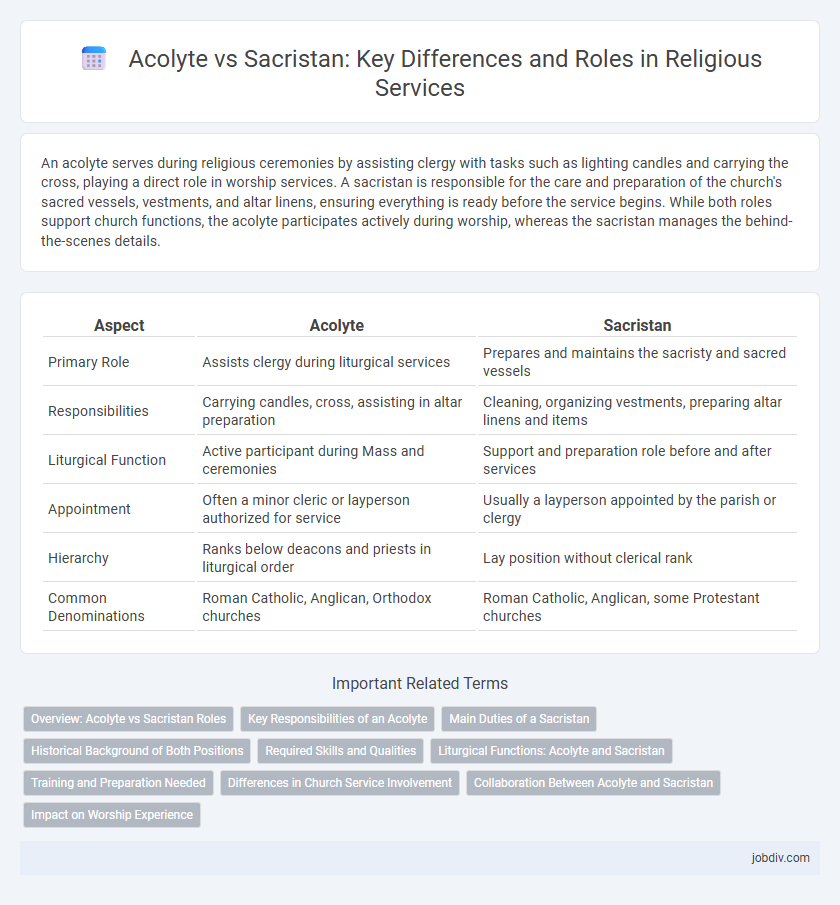An acolyte serves during religious ceremonies by assisting clergy with tasks such as lighting candles and carrying the cross, playing a direct role in worship services. A sacristan is responsible for the care and preparation of the church's sacred vessels, vestments, and altar linens, ensuring everything is ready before the service begins. While both roles support church functions, the acolyte participates actively during worship, whereas the sacristan manages the behind-the-scenes details.
Table of Comparison
| Aspect | Acolyte | Sacristan |
|---|---|---|
| Primary Role | Assists clergy during liturgical services | Prepares and maintains the sacristy and sacred vessels |
| Responsibilities | Carrying candles, cross, assisting in altar preparation | Cleaning, organizing vestments, preparing altar linens and items |
| Liturgical Function | Active participant during Mass and ceremonies | Support and preparation role before and after services |
| Appointment | Often a minor cleric or layperson authorized for service | Usually a layperson appointed by the parish or clergy |
| Hierarchy | Ranks below deacons and priests in liturgical order | Lay position without clerical rank |
| Common Denominations | Roman Catholic, Anglican, Orthodox churches | Roman Catholic, Anglican, some Protestant churches |
Overview: Acolyte vs Sacristan Roles
Acolytes serve by assisting clergy during liturgical services, managing candles, preparing the altar, and participating in processions. Sacristans hold responsibility for maintaining the sacristy, caring for vestments, sacred vessels, and ensuring the altar is properly prepared for worship. Both roles support church rituals but focus on distinct aspects: acolytes engage directly in the ceremony, while sacristans handle behind-the-scenes preparations.
Key Responsibilities of an Acolyte
An acolyte serves as a vital assistant during liturgical ceremonies, carrying out responsibilities such as lighting altar candles, preparing the altar for the Eucharist, and assisting the clergy with sacred vessels and vestments. They ensure the smooth flow of the Mass by guiding processions and managing liturgical objects with reverence. Their role emphasizes service, attentiveness, and deep understanding of the ritual elements in Christian worship.
Main Duties of a Sacristan
A sacristan is primarily responsible for the care, preparation, and maintenance of the sacristy, sacred vessels, vestments, and altar linens, ensuring everything is in proper order for liturgical services. This role includes setting up the altar for Mass, overseeing the inventory of liturgical items, and coordinating with clergy and acolytes to support worship activities. The sacristan also manages the cleaning and organization of the church sanctuary, safeguarding valuable religious artifacts and facilitating smooth ceremonial practices.
Historical Background of Both Positions
The role of the acolyte originated in early Christian liturgy as a minor clerical order responsible for assisting the clergy during mass and carrying candles or sacred vessels. The sacristan, historically rooted in medieval church traditions, managed the sacristy, ensuring the care and preparation of liturgical items and the church's physical space. Both positions evolved with distinct but complementary duties integral to the organization and sanctity of worship services.
Required Skills and Qualities
Acolytes must possess attentiveness, reverence, and basic liturgical knowledge to assist effectively during worship services. Sacristans require organizational skills, attention to detail, and the ability to maintain sacred vessels, vestments, and altar supplies. Both roles demand a deep respect for religious traditions and a commitment to supporting the smooth conduct of ritual ceremonies.
Liturgical Functions: Acolyte and Sacristan
Acolytes assist during liturgical ceremonies by preparing the altar, lighting candles, and carrying processional items, enhancing the solemnity of worship services. Sacristans oversee the care and maintenance of sacred vessels, vestments, and the church sanctuary, ensuring all liturgical items are properly arranged and ready for use. Both roles are essential for the smooth execution of liturgical functions, with acolytes focusing on active participation during rites and sacristans managing the preparatory and restorative tasks.
Training and Preparation Needed
Acolytes undergo specific training focused on liturgical duties, such as carrying candles, assisting during the Eucharist, and understanding ceremonial protocols, often guided by clergy or experienced laypersons. Sacristans require comprehensive preparation in managing the sacristy, including the care of vestments, sacred vessels, and altar linens, as well as familiarity with liturgical calendar and rituals. Both roles demand disciplined instruction to ensure proper execution of their responsibilities within religious services.
Differences in Church Service Involvement
Acolytes assist directly during liturgical ceremonies by carrying candles, preparing the altar, and participating in processions, enhancing the worship experience. Sacristans manage the preparation and maintenance of sacred vessels, vestments, and church furnishings, ensuring everything is ready before and after services. The acolyte's role is active within the service, while the sacristan's responsibilities focus on behind-the-scenes organization and care.
Collaboration Between Acolyte and Sacristan
The collaboration between acolytes and sacristans ensures the smooth execution of liturgical ceremonies, where acolytes assist in altar duties and sacristans manage the preparation and care of sacred vessels and vestments. Effective coordination enhances the reverence and order of worship services, fostering a respectful environment. Their partnership reflects a shared commitment to maintaining the sanctity and solemnity of religious rituals.
Impact on Worship Experience
Acolytes enhance the worship experience by leading liturgical ceremonies, managing candles, and assisting clergy during sacraments, creating a solemn and orderly atmosphere. Sacristans ensure the smooth flow of services by preparing sacred vessels, vestments, and altar requisites, contributing to the reverence and sanctity of worship. Both roles significantly impact congregational participation and the overall spiritual ambiance of religious ceremonies.
Acolyte vs Sacristan Infographic

 jobdiv.com
jobdiv.com